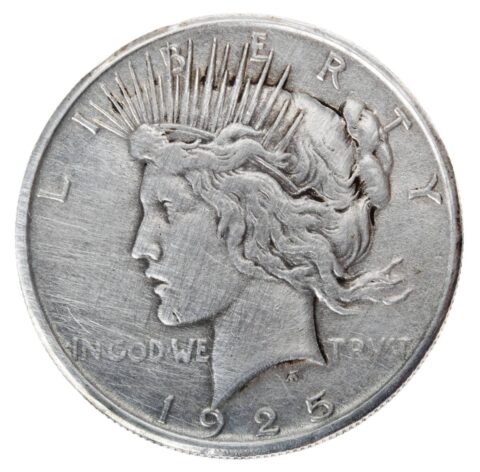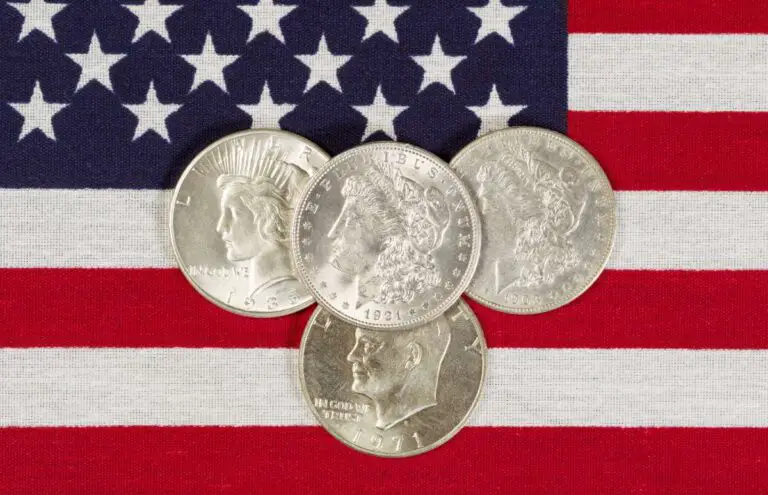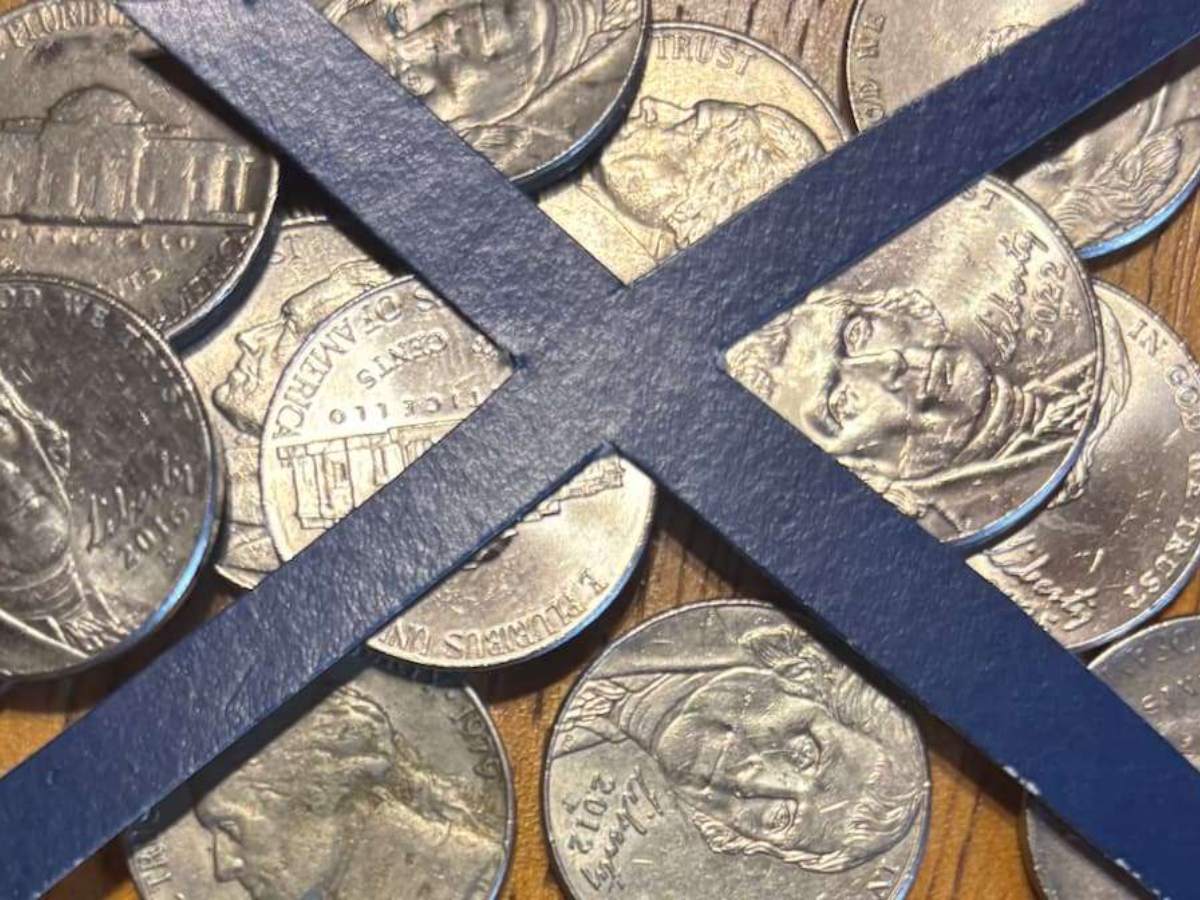How To Grade U.S. Dollar Coins
Before you can determine the value of a coin, you first need to know what condition it is in — or its “grade.”
I’ve previously provided information to help you get an approximate idea of the grade of your coin.
Today, I’m going to go into detail showing you how to obtain exact grades for your circulated silver dollars.
There are 3 types of silver dollar coins that I will cover here:
- Eisenhower silver dollars (1971–1978)
- Peace silver dollars (1921–1935)
- Morgan silver dollars (1878–1921)
Here’s what the coin grade abbreviations and numbers mean. Plus, an explanation of the various parts of a coin.
Let’s start with the most common one, the Eisenhower dollar coin…
Eisenhower Silver Dollar Grades

AU-55
- Obverse: Only a trace of wear shows on the highest points of the jawbone and at center of neck.
- Reverse: A trace of wear shows at high points of feathers in wings and legs. Nearly all mint luster still present.
EF-45
- Obverse: Slight wear shows on cheek, along jawbone, and on high points at edge of bust. Hairlines are sharp and detailed.
- Reverse: High points of head, legs, and wing ridges are lightly worn. Central feathers are all clearly defined. 3/4 of mint luster still present.
VF-30
- Obverse: Wear spots show on hair below part and along cheek and jaw. Hairlines are weak but have nearly full visible details. Slight wear shows at center of neck and along edge of bust.
- Reverse: Wear shows on head and feathers in wings and legs but all details are visible. All central tail feathers are plain. Wing and leg ridges are lightly worn.
Photo examples of Eisenhower dollar coin grades.
Peace Silver Dollar Grades

AU-55
- Obverse: Trace of wear shows on hair over ear and above forehead. Slight wear visible on cheek.
- Reverse: High points of feathers on right wing show a trace of wear. Most of mint luster still present although marred by light bag marks and surface abrasions.
AU-50
- Obverse: Traces of wear visible on neck and hair over ear and above forehead. Cheek shows slight wear.
- Reverse: Traces of wear show on head and high points of feathers on right wing. 3/4 of mint luster still present. Surface abrasions and bag marks are more noticeable than for AU-55.
EF-45
- Obverse: Hair around face shows slight wear but most hair strands are visible. Lower edge of neck lightly worn.
- Reverse: Top of neck and head behind eye show slight wear. Central wing and leg feathers lightly worn. Half of mint luster still present.
EF-40
- Obverse: Slight flattening visible on high points of hair. Most hair strands clearly separated. Entire face and lower edge of neck lightly worn.
- Reverse: Wear shows on head behind eye and top of neck. Some flat spots visible on central wing and leg feathers. Partial mint luster is visible.
Photo examples of Peace dollar coin grades.
Morgan Silver Dollar Grades

AU-55
- Obverse: Slight trace of wear shows on hair above ear and eye, edges of cotton leaves, and high upper fold of cap. Luster fading from cheek.
- Reverse: Slight trace of wear shows on breast, tops of legs, and talons. Most of mint luster still present although marred by light bag marks and surface abrasions.
AU-50
- Obverse: Traces of wear show on hair above eye and ear, edges of cotton leaves, and high upper fold of cap. Partial detail visible on tops of cotton blossoms. Luster gone from cheek.
- Reverse: There are traces of wear on breast, tops of legs, wing tips, and talons. 3/4 of mint luster still present. Surface abrasions and bag marks are more noticeable than for AU-55.
EF-45
- Obverse: Slight wear on hair above date, forehead, and ear. Lines in hair well detailed and sharp. Slight flat spots on edges of cotton leaves. Minute signs of wear on cheek.
- Reverse: High points of breast are lightly worn. Tops of legs and right wing tip show wear. Talons are slightly flat. Half of mint luster still present.
EF-40
- Obverse: Wear shows on hair above date, forehead, and ear. Lines in hair well detailed. Flat spots visible on edges of cotton leaves. Cheeks lightly worn.
- Reverse: Almost all feathers gone from breast. Tops of legs, wing tips, and feathers on head show wear. Talons are flat. Partial mint luster visible.
VF-30
- Obverse: Wear shows on high points of hair from forehead to ear. Some strands visible in hair above ear. There are smooth areas on cotton leaves and at top of cotton blossoms.
- Reverse: Wear shows on leaves of wreath and tips of wings. Only a few feathers visible on breast and head.
VF-20
- Obverse: Smooth spots visible on hair from forehead to ear. Cotton leaves heavily worn but separated. Wheat grains show wear.
- Reverse: Some leaves on wreath are well worn. Breast is smooth and only a few feathers show on head. Tips of wings are weak but lines are complete.
F-12
- Obverse: Hairline along face is clearly defined. Lower 2 cotton leaves are smooth but distinct from cap. Some wheat grains merging. Cotton blossoms flat but the two lines in each show clearly.
- Reverse: 1/4 of eagle’s right wing and edge of left wing are smooth. Head, neck, and breast are flat and merging. Tail feathers slightly worn. Top leaves in wreath show heavy wear.
VG-8
- Obverse: Most details in hair are worn smooth. All letters and date are clear. Cotton blossoms flat and leaves merging in spots.
- Reverse: Hair of eagle’s right wing and 1/3 of left wing are smooth. All leaves in wreath are worn. Rim is complete.
G-4
- Obverse: Hair is well worn with very little detail remaining. Date, letters, and design clearly outlined. Rim is full.
- Reverse: Eagle is worn nearly flat but is completely outlined. Design elements smooth but visible. Legend is all visible and rim is full.
AG-3
- Obverse: Head is outlined with nearly all details worn away. Date readable but worn. Legend merging into rim.
- Reverse: Entire design partially worn away. Rim merges into legend.
Photo examples of Morgan dollar coin grades.
The Bottom Line…

It takes a lot of time and experience to consistently grade coins accurately, but you’ll never get there if you don’t start somewhere.
Hopefully you’re able to grade your Eisenhower silver dollars, Peace silver dollars, and Morgan silver dollars better now.
This video will help you grade coins at home yourself:
You’re also going to need this Coin Grading Standards book and a good coin magnifier to grade your own coins.
READY FOR THE NEXT STEP?… Learn How To Appraise Coins Yourself And Determine Their Value



